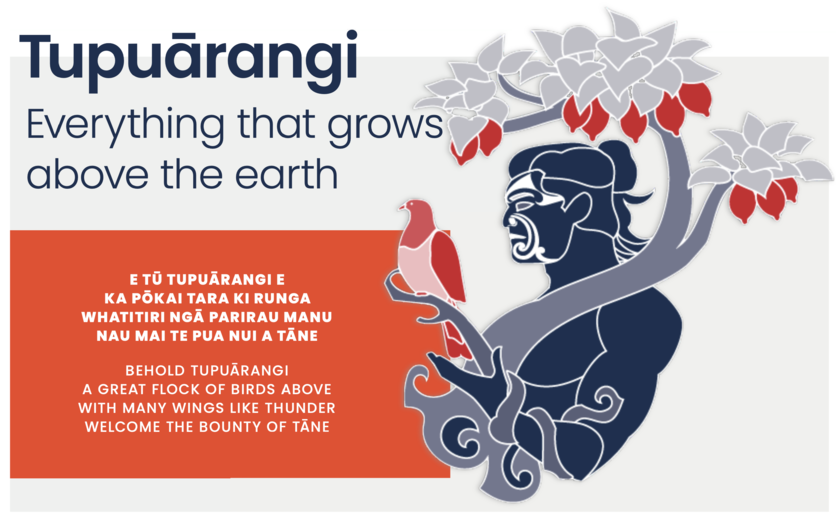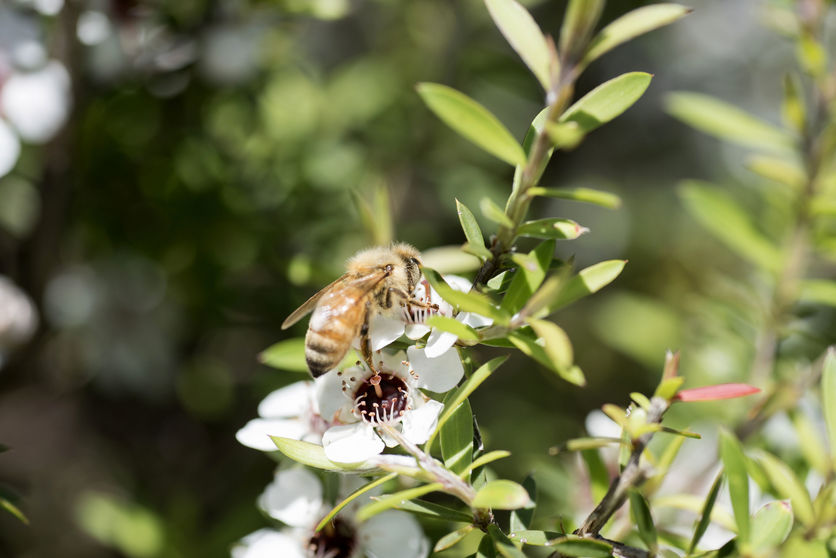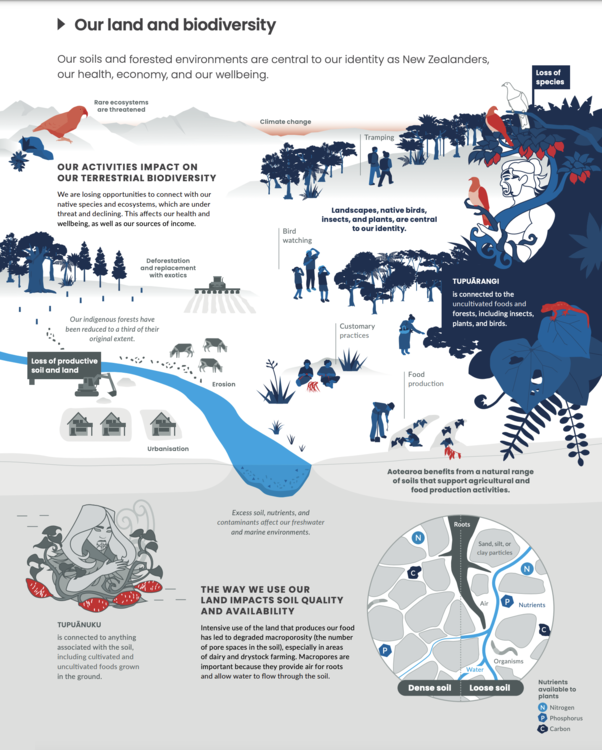Tupuārangi is a whetū in the Matariki cluster. It is connected to food and growth above the ground and has a strong connection with birds.
Aotearoa New Zealand’s Ministry for the Environment and Stats NZ have produced Environment Aotearoa 2022 as part of its environmental reporting series. Environment Aotearoa 2022 has a unique approach that uses Te Kāhui o Matariki as the guiding framework for the report. Learn more about this approach in the article Environment Aotearoa 2022 – introduction.
Tupuārangi represents land-based ecosystems, in particular the ngahere (forests). The report includes a special focus on kererū, harakeke and mānuka – key species that illustrate our connection to Tupuārangi.
Tupuārangi is comprised of two words: ‘tupu’, which can mean ‘new shoot’ or ‘to grow’, and rangi (sky), an abbreviation of ‘Ranginui’ (sky father). Tupuārangi has influence over the domains of Tāne, the atua of the forest, Haumietiketike, the atua of uncultivated foods and insects, and Tūtewehiwehi, the father of reptiles, fern roots, nīkau, harakeke, and silver tree fern (ponga).
Environment Aotearoa 2022
Our connection to Tupuārangi
Environment Aotearoa 2022 explores some of the connections that the people of Aotearoa have with nature. Te ao Māori perspectives consider ecosystems in their entirety, so any shift in the mauri of any part of an ecosystem eventually affects the whole system. The harvesting of resources and environmental damage or pollution can cause the loss of mauri. The report highlights the inherent connections of Tūhoe Tuawhenua with kererū, Rakiura Māori with tītī (muttonbirds) and mana whenua with harakeke. Download this section of the report as a PDF.
Maintaining and rebuilding connections to customary harvesting of mahinga kai reconnects people with land (whenua), wetlands (repo) and other ecosystems. It also supports the passage of mātauranga and reo to the generations to come.
Ngahere, greenspaces and wellbeing
Our forests and greenspaces contribute to our wellbeing by giving us experiences and a sense of place and enhancing our understanding of the environment. A Department of Conservation survey found that 84% of the people surveyed felt having access to the outdoor spaces of Aotearoa is a major advantage of living here. We also benefit from urban greenspaces – for example, increased physical activity, greater emotional wellbeing and stronger social connections.
Forests also provide important economic benefits, which support people’s livelihoods. Timber from plantation forests is one of our major export revenue earners – 2020 forestry exports were valued at $5.5 billion. Honey is another important product we obtain from forest ecosystems. Mānuka honey in particular is an important export earner.
The state of Tupuārangi
The article Pōhutukawa – pressures on the environment outlines many of the issues that impact our ngahere ecosystems. Native forests have been steadily removed since humans arrived, with less than one-third of the original forested areas remaining. The loss of forest and wetland habitats along with the introduction of mammalian predators have severely reduced the populations of many of our unique birds, reptiles and plants.
Pressures on the taonga species mentioned earlier are representative of our impacts:
- Kererū populations are stable but they are ‘conservation dependent’, which means they are dependent on ongoing conservation efforts such as pest control. In some parts of the motu, caring for kererū also requires our efforts to ensure the availability of food and forest habitats.
- Harakeke grows throughout Aotearoa, but it is likely that some special cultivars cultivated by Māori for weaving may have gone extinct.
- Mānuka is widespread throughout Aotearoa, but between 2001 and 2018, the area has decreased and some variants are threatened. Myrtle rust is posing an increasing risk on the mānuka honey industry and other species of the Myrtaceae family.
Caring for Tupuārangi
Our special connections to the ngahere and our quirky native species have been the inspiration for large and small-scale restoration projects around the motu. Mātauranga Māori is invaluable for establishing the ecological whakapapa of the area. Restoration is not only about the physical replanting. It is also about healing.
Related content
We’ve curated conservation resources (articles, activities and media) under the following topics:
- He kōrero hei āwhina i te kaiako – Te Reo o Te Repo
- Repo (wetlands)
- Conserving native birds
- New Zealand native trees
- Nature – a context for learning
- Ferns
- 1080 – a wicked problem
Find out about the National New Zealand Flax Collection and a South Island harakeke collection in the Dunedin Botanic Garden.
Palaeo-ecology, archaeology and matāuranga Māori share philosophies of learning from the past. Could this lead to the resumption of traditional harvesting practices of some native species?
The Science Learning Hub team has curated a collection of resources to support Matariki and Environment Aotearoa 2022. This collection provides additional context and pedagogical insights. Log in to make this collection part of your private collection, just click on the copy icon. You can then add additional content and notes and make other changes.
Useful links
Stats NZ and the Ministry for the Environment report on different aspects of Aotearoa New Zealand’s environment every 6 months. Access their reports here.
Visit Stats NZ for more information on indigenous land cover, rare ecosystems and extinction threat to indigenous land species.
Acknowledgement
This resource has been produced in collaboration with the Ministry for the Environment and Stats NZ.




